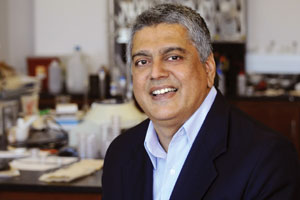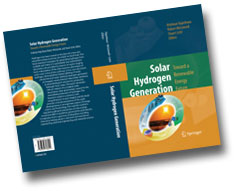RE:
SEARCH
Fuel of the future?
Professor eyes hydrogen as energy alternative

Dr. Krishnan Rajeshwar
nergy guru Krishnan Rajeshwar and futurist Jules Verne share a daring idea, though their lives are more than a century apart: It’s that the simplest element in the universe, hydrogen, will eventually replace fossil fuels. Partly, anyway.
Verne said exactly that back in 1874 in The Mysterious Island, calling hydrogen “the coal of our future.” That was, of course, before oil became the coal of our future.
Dr. Rajeshwar, distinguished professor of chemistry and biochemistry and associate dean of the College of Science, doesn’t wax quite so expansively about the future of hydrogen as Verne. He does, however, prognosticate that the simplest and lightest element in the periodic table has great potential as a fuel of the future. This is also an area of study in which Rajeshwar is recognized as a global authority.
He is, in fact, the lead editor and co-author of a new book on that topic that is gaining attention in both the scientific and lay communities.
Solar Hydrogen Generation: Toward a Renewable Energy Future (Springer, 2008) examines strategies for generating hydrogen from water using energy from sunlight, albeit with a variety of scientific strategies.
Virtually the first bit of chemistry that elementary students learn is that a molecule of water is composed of two atoms of hydrogen and one of oxygen. It’s no great trick to separate hydrogen from water. The question is one of cost. Hydrogen as a fuel for mass consumption has many problems, but the first is that making it from water is energy intensive. And energy is expensive.
“That’s why the holy grail of hydrogen production involves finding a way to use a renewable source of energy—sunlight—to power the process,” Rajeshwar says. “The book is really a basic treatment on the disciplines of solar energy conversion.”
Those include electrochemistry, photochemistry, photoelectrochemistry, materials chemistry, device physics/engineering such as fuel cells and biology—all science-speak for ways to use sunlight as a relatively inexpensive power source.
Hydrogen produced from water offers a big three of distinct advantages. The first is that the supply of water on the planet is vast. The second is that when hydrogen is burned, it combines with oxygen and becomes water again—virtually equivalent to distilled water at that. In short, the supply of hydrogen is for all practical purposes endless and renewable.

- Dr. Krishnan Rajeshwar
“The third advantage is that using hydrogen as a fuel leaves virtually zero carbon footprint [carbon dioxide],” Rajeshwar says.
Carbon dioxide in the atmosphere has been steadily building since the advent of the Industrial Age, and its accumulation has increased with fossil fuel burning and internal combustion engines.
So does that mean Jules Verne was right about hydrogen? Perhaps some day, but Rajeshwar isn’t ready to put all the planet’s future energy needs in the hydrogen basket.
“I hope I’m wrong, but I don’t see it as a mass consumption fuel for 15 to 30 years,” he says. “It’s more than a problem of producing hydrogen cheaply. There are massive issues with both storage and distributions.”
There is, he says, no one answer to civilization’s power needs. “It’s going to take a lot of answers—solar, wind power, tidal, nuclear and others—to solve both our energy and pollution problems.”
Rajeshwar’s participation in finding some of those answers is more than theoretical. He’s involved, for instance, with a $1.23 million renewable energy hydrogen research grant funded by the U.S. Department of Energy, as well as a photo-assisted electrosynthesis research project ($303,000) through the Department of Energy. He also hopes that a variety of projects he’s part of through the Sid Richardson Carbon and Energy Co. translate to more efficient and economical hydrogen fuel cells.
In the meantime, he’s willing to predict what the next major source of transit-oriented power will be—and it’s not hydrogen.
“More practical for the moment are energy sources like lithium ion batteries,” he says. “We’re going to see much more of those. Most certainly for the next generation of hybrids, we’ll be seeing plug-in lithium ion batteries. That technology is here already.”
— O.K. Carter
Other Stories
Deans named
for School of Urban and Public Affairs, Honors College
Study shows teen victims seek friends' help
United they stood
Supporters convinced legislators to trumpet the University’s research strengths
UT Arlington's new mace
Art meets Academia
Search
Contact Us
Office of University Publications
502 S. Cooper St.279 Fine Arts Building
Box 19647
Arlington, TX 76019-0647
